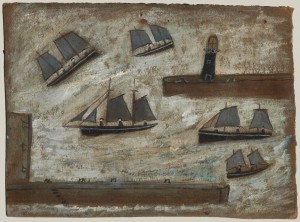
If you have any lingering notion that British art isn’t riven to the core with ideas of class, consider Alfred Wallis. Because Alfred Wallis, in his lifetime and in the seventy years since his death, has been the most patronised man in the country.
Wallis was a Cornishman, a sailor by trade who, on leaving the sea, made his living as a rag and bone man. After his wife’s death when he was seventy years old, he did something that inspires an unlovely comic surprise in the middle class onlooker: he took up painting.
And darling, how sweetly, how humbly he went about it! Using enamel or household paint, he’d find and use spare bits of timber and cardboard for his canvases, and paint ships. What’s more – widen the eyes and whisper – his paintings are actually jolly good.
Isn’t that just the most…? and so it goes on. Of course, it’s all because there are certain places artists don’t come from, and backgrounds they don’t emerge from. Artists – trained at the Slade and St Martins – go to St Ives, for the light and the authenticity. They aren’t born there, they don’t grow up there. And if you must be a working class artist, then for heaven’s sake make sure that you come from a big city and make sure you get into the right circles at the earliest poss.
Wallis was painting for himself; for his own, inner reasons, and that, on top of everything else, sets the critics off. Because it wasn’t just that he didn’t accept the authority and standing of the art world of his day; it was that he showed no interest, of his own, in them at all. And yet his works were as close to genius as any you could point to in British painting’s twentieth century.
That he was a natural master of composition strikes the newcomer to his paintings straight away. The best, in that sense, of the century, the man who knew, as no one else seems to have done, how to place the elements within the frame so that they strike you, immediately, as having a correctness strong enough to convey a wordless meaning of its own.
But Wallis’s works also possess, without exception, a presence and an evocativeness that no other British painter of the era comes close to. His paintings occupy the room space with you. Like the Tate’s Rothkos, they make you constantly aware of them. For the time you remain in the room, you will be unable to take your attention entirely away from them, and when you leave the room, you’ll feel a drop in tension. Some would say that they feel alive.
At the same time, they are hugely about what they are about: shipping around the coast of Cornwall, and they are a better source of recall of something that was and is no longer real than moving film or photography.
What few records we have of Wallis’s thoughts indicate that he, although close to genius, didn’t see what he was doing as an expression of talent, but just as the thing he had to do, for his own reasons. He had no opinion on “where it came from” and I think this relates him closely to the bulk of artists who, questioned closely, admit that they have no idea, discipline aside, “where” the words, pictures or songs actually emanate from. Artists rarely have the experience that their real work emanates from the same place as their felt personality. Neither did Wallis.
To anyone who has ever retreated from an art shop in shock and despair at the price of paints, brushes and canvas, it can feel as if Wallis had no right to do what he did. Because he never seems to have considered the need for anything other than what he had at hand: he didn’t have the thought that he needed to go shopping before he could start. He didn’t think he needed practice or training or the right kind of mood, before he could start.
That’s not to do down people who have had those thoughts: these are actually pretty mountainous issues to get over if you have them. But it is a clue to something that might become apparent further down the line: it really is the work, not the outcome or result, that is paramount. It really is the doing of things.
There are no signs that Wallis “developed”, by the way. There is no Wallis juvenilia. Like the young woman who, in 1988, came second in the National Poetry Competition with her first poem, it seems all to have been there at the beginning. Robert Cumming wrote of Wallis that he “died unhappy, alone and disturbed”. He might not have been born into a British artist’s accepted background, but don’t let it be said that he didn’t die like one.
For more of Wallis’ work and life, click here to visit the superb Wallis Gallery.

I just discovered this painter, while looking for something else on the web. never heard of him before, enchanted by what I find. love your article about the man (and “the artscene” thatI stay away from as far as possible). thank you for this !